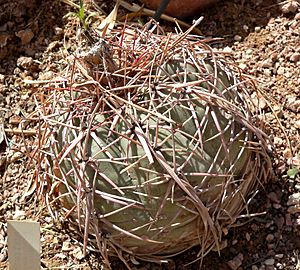Echinocactus horizonthalonius facts for kids
Quick facts for kids Echinocactus horizonthalonius |
|
|---|---|
 |
|
| Conservation status | |
| Scientific classification | |
| Kingdom: | |
| (unranked): | |
| (unranked): | |
| (unranked): | |
| Order: | |
| Family: | |
| Subfamily: | |
| Tribe: |
Cacteae
|
| Genus: | |
| Species: |
E. horizonthalonius
|
| Binomial name | |
| Echinocactus horizonthalonius Lem.
|
|
The Echinocactus horizonthalonius is a type of cactus that grows in the deserts. People call it by many names, like devilshead, turk's head cactus, blue barrel cactus, and eagle's claw. It's also known as horse maimer or horse crippler because its spines can be quite sharp. In Spanish, it's called visnaga meloncillo.
This cactus is found in the southwestern United States and northern Mexico. It especially likes to grow in the Chihuahuan Desert and Sonoran Desert, often on limestone rocks. One special kind of this cactus is even an endangered species in the United States.
Contents
What Does It Look Like?
This cactus can be gray-green or blue-gray. It can be shaped like a ball, half a ball, a tall column, or even flat on top. It can grow up to about 45 centimeters (18 inches) tall and 20 centimeters (8 inches) wide.
The cactus body has curving sections that twist around it like a spiral. These sections have small bumps called areoles. Each areole can have up to 10 spines. These spines can be pink, gray, or brown and can be longer than 4 centimeters (1.5 inches).
Its Flowers
The flowers of the Echinocactus horizonthalonius are bright pink to magenta (a deep purplish-red). They can be as wide as 7 to 9 centimeters (about 3.5 inches).
These flowers usually open around noon and close up for the night. They also tend to open after the cactus gets some rain. Most flowers bloom in June, but if it rains later in the summer or fall, the cactus might bloom again!
Its Fruit
After the flowers, the cactus grows a fruit. This fruit is fuzzy or woolly and can be pink or red.
Different Types of This Cactus
There are two main types, or varieties, of the Echinocactus horizonthalonius cactus.
Common Type
The more common type is called Echinocactus horizonthalonius var. horizonthalonius. You can find this one in the Chihuahuan Desert. It grows from Arizona, through New Mexico, into Texas, and also in northeastern Mexico. You can learn more about it here: USDA: Echinocactus horizonthalonius var. horizonthalonius
Rare Type: Nichol's Turk's Head Cactus
The other type is very rare. It's called Echinocactus horizonthalonius var. nicholii, or Nichol's turk's head cactus. This rare cactus is only found in a few places. There are three groups of them in the Sonoran Desert in southeastern Arizona, and one group in Sonora, Mexico.
This rare variety is listed as an endangered species in the United States. This means it's in danger of disappearing forever. Some groups of these cacti are protected in the Ironwood Forest National Monument in Pinal and Pima Counties in Arizona.
Why It's Endangered
Several things threaten this rare cactus:
- Mining: People digging for limestone can destroy its habitat.
- Off-roading: Vehicles driving off roads can crush the plants.
- Collecting: Some people illegally collect these cacti because their flowers are pretty.
- Buffelgrass: An invasive grass called Buffelgrass is also a big problem. It spreads easily and can cause wildfires in the desert, which the cacti are not used to.
Helping the Cactus
Luckily, there has been some success in protecting this rare cactus. A big part of this success comes from controlling and removing the buffelgrass to prevent fires.
See also
 In Spanish: Echinocactus horizonthalonius para niños
In Spanish: Echinocactus horizonthalonius para niños


